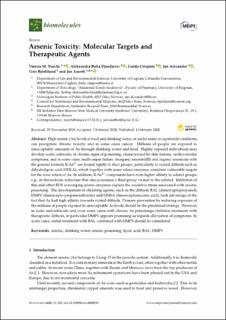| dc.contributor.author | Nurchi, Valeria Marina | |
| dc.contributor.author | Djordjevic, Aleksandra Buha | |
| dc.contributor.author | Crisponi, Guido | |
| dc.contributor.author | Alexander, Jan | |
| dc.contributor.author | Bjørklund, Geir | |
| dc.contributor.author | Aaseth, Jan | |
| dc.date.accessioned | 2021-04-23T14:01:41Z | |
| dc.date.available | 2021-04-23T14:01:41Z | |
| dc.date.created | 2020-04-29T14:40:50Z | |
| dc.date.issued | 2020 | |
| dc.identifier.citation | Biomolecules. 2020, 10 (2), . | en_US |
| dc.identifier.issn | 2218-273X | |
| dc.identifier.uri | https://hdl.handle.net/11250/2739401 | |
| dc.description.abstract | High arsenic (As) levels in food and drinking water, or under some occupational conditions, can precipitate chronic toxicity and in some cases cancer. Millions of people are exposed to unacceptable amounts of As through drinking water and food. Highly exposed individuals may develop acute, subacute, or chronic signs of poisoning, characterized by skin lesions, cardiovascular symptoms, and in some cases, multi-organ failure. Inorganic arsenite(III) and organic arsenicals with the general formula R-As2+ are bound tightly to thiol groups, particularly to vicinal dithiols such as dihydrolipoic acid (DHLA), which together with some seleno-enzymes constitute vulnerable targets for the toxic action of As. In addition, R-As2+-compounds have even higher affinity to selenol groups, e.g., in thioredoxin reductase that also possesses a thiol group vicinal to the selenol. Inhibition of this and other ROS scavenging seleno-enzymes explain the oxidative stress associated with arsenic poisoning. The development of chelating agents, such as the dithiols BAL (dimercaptopropanol), DMPS (dimercapto-propanesulfonate) and DMSA (dimercaptosuccinic acid), took advantage of the fact that As had high affinity towards vicinal dithiols. Primary prevention by reducing exposure of the millions of people exposed to unacceptable As levels should be the prioritized strategy. However, in acute and subacute and even some cases with chronic As poisonings chelation treatment with therapeutic dithiols, in particular DMPS appears promising as regards alleviation of symptoms. In acute cases, initial treatment with BAL combined with DMPS should be considered. | en_US |
| dc.description.sponsorship | This research was partially funded by Innlandet Hospital Trust, Norway. VMN thanks Regione Autonoma della Sardegna for the financial support of the project RASSR79857. | en_US |
| dc.language.iso | eng | en_US |
| dc.publisher | MDPI | en_US |
| dc.relation.uri | https://www.mdpi.com/2218-273X/10/2/235 | |
| dc.rights | Navngivelse 4.0 Internasjonal | * |
| dc.rights.uri | http://creativecommons.org/licenses/by/4.0/deed.no | * |
| dc.subject | arsenic | en_US |
| dc.subject | drinking water | en_US |
| dc.subject | arsenic poisoning | en_US |
| dc.subject | lipoic acid | en_US |
| dc.subject | BAL | en_US |
| dc.subject | DMPS | en_US |
| dc.title | Arsenic toxicity: Molecular targets and therapeutic agents | en_US |
| dc.type | Peer reviewed | en_US |
| dc.type | Journal article | en_US |
| dc.description.version | publishedVersion | en_US |
| dc.rights.holder | © 2020 by the authors. Licensee MDPI, Basel, Switzerland. This article is an open access article distributed under the terms and conditions of the Creative Commons Attribution (CC BY) license (http://creativecommons.org/licenses/by/4.0/). | en_US |
| dc.source.pagenumber | 16 | en_US |
| dc.source.volume | 10 | en_US |
| dc.source.journal | Biomolecules | en_US |
| dc.source.issue | 2 | en_US |
| dc.identifier.doi | 10.3390/biom10020235 | |
| dc.identifier.cristin | 1808687 | |
| cristin.ispublished | true | |
| cristin.fulltext | original | |
| cristin.qualitycode | 1 | |

